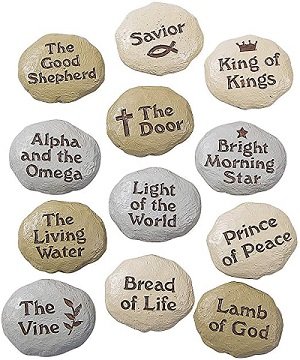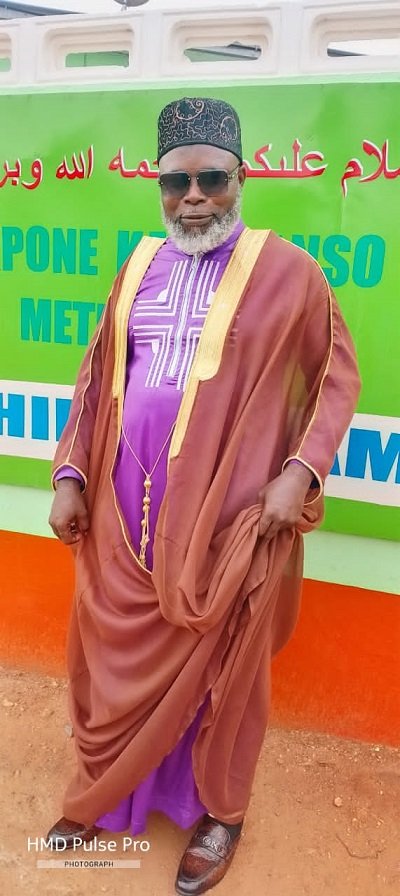Fruitful Living
The Biblical names and titles of Jesus Christ – Part 2

Yet for us there is but one God, the Father, from whom all things came and for whom we live; and there is but one Lord, Jesus Christ, through whom all things came and through whom we live. – 1 Corinthians 8:6
We continue our study this week with more Biblical names and titles ascribed to Jesus Christ.
1. HOLY ONE OF GOD; “Why are you interfering with us, Jesus of Nazareth? Have you come to destroy us? I know who you are—the Holy One of God!” – Mark 1:24
2. HOLY ONE OF ISRAEL; Though you are a lowly worm, O Jacob, don’t be afraid, people of Israel, for I will help you. I am the Lord, your Redeemer. I am the Holy One of Israel.’ – Isaiah 41:14.
3. HORN OF SALVATION; The Lord is my rock, my fortress and my deliverer; my God is my rock, in whom I take refuge, my shield and the horn of my salvation, my stronghold.–Psalm 18:2
4. I AM THE BREAD OF LIFE; Then Jesus declared, “I am the bread of life. Whoever comes to me will never go hungry, and whoever believes in me will never be thirsty. – John 6:35.
5. I AM THE LIGHT OF THE WORLD;While I am in the world, I am the light of the world.” – John 9:35
6. I AM THE GOOD SHEPHERD; “I am the good shepherd. The good shepherd lays down His life for the sheep. –John 10:11
7. I AM THE DOOR;I am the gate; whoever enters through me will be saved.[a] They will come in and go out, and find pasture.–John 10:9
8. I AM THE RESURRECTION; “Jesus said to her, “I am the resurrection and the life. The one who believes in me will live, even though they die–John 11:25.
9. I AM THE TRUE VINE; I am the true vine, and my Father is the gardener. – John 15:1
10. I AM THE WAY; Jesus answered, “I am the way and the truth and the life. No one comes to the Father except through me. –John 14:6
11. JESUS; She will give birth to a son, and you are to give Him the name Jesus because He will save His people from their sins.”, – Matthew 1:21.
12. JUDGE; He commanded us to preach to the people and to testify that He is the one whom God appointed as judge of the living and the dead.–Acts 10:42.
13. KING OF ISRAEL; He saved others,” they said, “but He can’t save himself! He’s the king of Israel! Let Him come down now from the cross, and we will believe in Him.–Matthew 27:42.
14. KING OF KINGS; They will wage war against the Lamb, but the Lamb will triumph over them because He is Lord of lords and King of kings—and with Him will be His called, chosen and faithful followers.”- Revelation 17:14
15. LAMB OF GOD; The next day John saw Jesus coming toward him and said, “Look, the Lamb of God, who takes away the sin of the world! – John 1:29.
16. LION OF THE TRIBE OF JUDAH; Then one of the elders said to me, “Do not weep! See, the Lion of the tribe of Judah, the Root of David, has triumphed. He is able to open the scroll and its seven seals.”–Revelation 5:5.
17. MAN; For there is one God and one mediator between God and mankind, the man Christ Jesus – 1 Timothy 2:5
18. MESSIAH; The first thing Andrew did was to find his brother Simon and tell him, “We have found the Messiah” (that is, the Christ)–John 1:41.
19. MIGHTY GOD; For to us a child is born, to us a son is given, and the government will be on His shoulders. And he will be called Wonderful Counselor, Mighty God, Everlasting Father, Prince of Peace. – Isaiah 9:6.
20. NAZARENE; What do you want with us, Jesus of Nazareth? Have you come to destroy us? I know who you are—the Holy One of God!”.–Mark 1:24.
21. ONLY BEGOTTEN SON; No one has seen God at any time. The only begotten Son, who is in the bosom of the Father, He has declared Him. – John 1:18.
22. PASSOVER; “Therefore purge out the old leaven, that you may be a new lump, since you truly are unleavened. For indeed Christ, our Passover, was sacrificed for us..”–1 Corinthians 5:7.
23. PHYSICIAN; When Jesus heard that, He said to them, “Those who are well have no need of a physician, but those who are sick. – Matthew 9:12.
24. POTENTATE; which He will manifest in His own time, He who is the blessed and only Potentate, the King of kings and Lord of lords, – 1 Timothy 6:15
25. PRINCE; and killed the Prince of life, whom God raised from the dead, of which we are witnesses.–Acts 3:15.
26. PROPHET; For Moses truly said to the fathers, ‘The Lord your God will raise up for you a Prophet like me from your brethren. Him you shall hear in all things, whatever He says to you.–Acts 3:22.
27. PROPITIATION; And He Himself is the propitiation for our sins, and not for ours only but also for the whole world.’–1 John 2:2
28. PURIFIER; He will sit as a refiner and purifier of silver; he will purify the Levites and refine them like gold and silver. Then the Lord will have men who will bring offerings in righteousness.”–Malachi 3:3.
29. PRIEST; Therefore, since we have a great high priest who has ascended into heaven, Jesus the Son of God, let us hold firmly to the faith we profess-Hebrews 4:14.
CHRIST ABOVE ALL GLORY SEATED – MHB 225
1. Christ, above all glory seated,
King triumphant, strong to save!
Dying, you have death defeated,
Buried, you have spoiled the grave.
2 Thou art gone where now is given
What no mortal might could gain,
On the eternal throne of heaven
In Thy Father’s power to reign.
3 There Thy kingdoms all adore Thee,
Heaven above and earth below,
While the depths of hell before Thee
Trembling and defeated bow.
4 We, O Lord, With Hearts Adoring
Follow Thee Above The Sky!
Hear Our Prayers Thy Grace Imploring,
Lift Our Souls To Thee On High.
5So When Thou Again In Glory
On The Clouds Of Heaven Shalt Shine,
We Thy Flock May Stand Before Thee,
Owned For Evermore As Thine.
6Hail! All Hail! In Thee Confiding,
Jesus, Thee Shall All Adore,
In Thy Father’s Might Abiding
With One Spirit Evermore!
Translated by James Russel Woodford (1820-1885)
Source: Culled from Wilmington’s Guide to the Bible
Stay blessed!
By Dr. Joyce Aryee, the author
For further inquiries please contact us on Tel Nos. 0302-772013 or 0268130615
Email: saltnlightministries@gmail.com
Website: saltandlightministriesgh.org
Fruitful Living
Eid-ul-Adha: A living legacy of faith, sacrifice, and devotion

We begin in the name of Allah, the Most Merciful, the Most Compassionate. We praise Him, seek His help and forgiveness, and seek refuge in Him from the evils of our souls and the wrongs of our actions.
May peace and blessings be upon the Prophet Muhammad (peace be upon him), his family, his noble companions, and all those who follow his path until the Day of Judgment.
Understanding the essence
of Eid-ul-Adha
Eid-ul-Adha, the Festival of Sacrifice, is one of the two major Islamic celebrations observed by Muslims across the world.
It commemorates the unwavering submission of Prophet Ibrahim (Abraham, peace be upon him) to Allah’s command when he was prepared to sacrifice his beloved son Isma’il (Ishmael, peace be upon him). Allah, in His infinite mercy, intervened and replaced the son with a ram, thus honouring Ibrahim’s sincerity and faith.
This moment of sacrifice is recorded in the Qur’an: “Then when they had both submitted and he put him down upon his forehead, We called out: ‘O Ibrahim! You have fulfilled the vision.’ Indeed, We thus reward the doers of good.” (Surah As-Saffat, 37:103–105)
This act of obedience is not merely a historical account. It is a living symbol that forms the essence of Eid-ul-Adha.
Ibrahim (A.S): The Architect
of Submission
Before the moment of sacrifice, Prophet Ibrahim and his family played critical roles in establishing Islam’s foundational pillars:
1. The building of the Ka‘bah
Prophet Ibrahim and his son Isma’il were chosen to construct the Ka‘bah, the sacred House of Allah in Makkah. The Qur’an records this noble moment:
“And [mention] when Ibrahim was raising the foundations of the House and [with him] Isma’il, [saying], ‘Our Lord, accept [this] from us. Indeed, You are the Hearing, the Knowing.’”
(Surah Al-Baqarah 2:127)
This structure remains the spiritual centre of Muslim worship, facing which over a billion Muslims direct their daily prayers.
2. The struggle of Hajar (Hajara) between Safa and Marwa
The mother of Isma’il, Hajar (Hajara), exemplifies a profound lesson of patience and faith. Left in the barren valley of Makkah with her infant, she ran between the hills of Safa and Marwa, desperately searching for water. Her perseverance was rewarded when the well of Zamzam sprang forth at the feet of her baby.
Her sincere struggle is now ritualised in Hajj as the Sa‘i between Safa and Marwa—a reminder of the role of women, the power of du‘a, and the value of trust in Allah’s provision.
Sacrifice at Mina and the
Rites of Jamarat
During Hajj, pilgrims reenact Ibrahim’s confrontation with Shaytan at Mina, where he rejected the devil’s temptation and cast stones at him. This act is now observed in Hajj as the ritual of stoning the Jamarat, symbolising the rejection of evil, temptation, and disobedience.
It is a vivid spiritual lesson: the path to Allah is one of resistance to distraction and sin, and one must be prepared to fight these forces with unwavering faith.
The essence of Arafat in Hajj
The Prophet Muhammad said:“Hajj is Arafah.” (Sunan al-Tirmidhi, 889)
Standing on the plain of Arafat, in deep humility and supplication, is the heart of Hajj. It represents the Day of Judgment, when all of humanity will stand before their Creator. The Prophet said: “There is no day on which Allah frees more people from the Fire than the Day of Arafah.” (Sahih Muslim, 1348)
For pilgrims, Arafat is a time of repentance, reflection, and renewal— and for non-pilgrims, fasting on that day is highly recommended.
Three core lessons from the
Sacrifice of Prophet Ibrahim
(A.S.)
1. Absolute obedience to Allah
Ibrahim’s willingness to sacrifice his son teaches that the essence of faith is unquestioning obedience to Allah. He prioritised divine command over emotion, logic, or comfort.
Takeaway:
In our lives, we must also be ready to put aside our desires, egos, and even attachments if they conflict with Allah’s instructions. This may involve sacrifices such as waking up for Fajr, staying away from haram income, or being truthful in difficult situations.
2. Sincere intention and inner sacrifice
The real essence of the sacrifice lies in the heart’s submission to Allah.
It is neither their meat nor their blood that reaches Allah, but it is your piety that reaches Him.”
(Surah Al-Hajj 22:37)
Takeaway:
Every act of worship should be grounded in sincerity. Whether it is prayer, charity, or sacrifice, what matters most is the purity of our intention.
3. Sacrifice for the greater good
The legacy of Eid-ul-Adha teaches us that sometimes, faith requires us to give up what we love for a greater purpose. Sacrificing wealth, time, or status in the path of Allah or for the benefit of others leads to spiritual elevation.
Takeaway:
Use your resources such as time, money, skills, for acts of benefit: support the poor, educate the young, assist the sick, and build your community.
Celebrating Eid-ul-Adha: A
Festival for all Muslims
Even for those who do not go on Hajj, Eid-ul-Adha holds immense significance. Muslims across the world participate in the act of Qurbani (sacrifice) to honor the tradition of Ibrahim (A.S.).
Types of animals and their
symbolism
Permissible animals include goats, sheep, cows, and camels. Each must meet a minimum age and be free of defects. The sacrificed animal is then divided into three parts: one for the family, one for relatives and friends, and one for the poor and needy.
This distribution reflects the spirit of sharing, compassion, and social responsibility—values at the heart of Islam.
The eternal message of Eid-ul-Adha
Eid-ul-Adha is not merely a celebration; it is a living tradition that calls us to:
• Submit like Ibrahim,
• Strive like Hajar,
• Sacrifice like Isma’il,
• Reflect like the pilgrims at Arafat.
May this Eid awaken within us a renewed commitment to obedience, sincerity, and compassion.
Let us make every Eid-ul-Adha a step forward in our spiritual journey, embodying the values of submission, sacrifice, and service to humanity. I wish every Muslim Eid Mubaarak
By Imaam Alhaji Saeed Abdulai
(Kpone Katamanso Metropolitan Chief Imaam)
Fruitful Living
Steps taken by government to combat illicit drugs (Final part)
The Minister for the Interior, Muntaka Mohammed-Mubarak, has reaffirmed the government’s commitment to combating drug abuse and illicit trafficking for a safer environment which would
go a long way to make Ghana a drug-free country. 3News.com (2025)
Solutions to Illicit Drugs from the Islamic perspective
are comprehensive and emphasise of both prevention and treatment:
Tarbiyah (Islamic nurturing): Instilling strong Islamic values from childhood through Qur’anic education, regular prayer, and association with righteous companions.
Community preaching (Da’wah): Imams must consistently raise awareness during khutbahs and Islamic programs about the dangers of drugs and the beauty of a sober, productive life.
Faith-based rehabilitation: Mosques and Islamic centers can partner with medical institutions to offer Qur’an therapy, spiritual counseling, and structured recovery programs.
Islamic youth clubs: Providing youth with halal entertainment, mentorship, and purposeful engagement can steer them away from harmful peer groups.
Zakat and Sadaqah: Channelling funds to support families of victims and establishing centres for rehabilitation.
Role of Parents, Society, Muslim Chiefs and Imams:
Parents must be vigilant and provide emotional support. A loving, nurturing home reduces a child’s vulnerability to drugs.
Society should de-stigmatize addiction. Drug users should be seen as patients needing healing, not criminals deserving rejection.
Muslim Chiefs must lead community campaigns, setting moral examples and supporting policy enforcement.
Imams must be more than religious leaders—they must become counsellors, educators, and advocates. Their leadership can shift public perception and guide collective action.
Conclusion
Illicit drugs pose one of the most dangerous threats to our society, undermining our religious values, harming our youth, and destroying our future. The Islamic position is clear and
Unequivocal: such substances are forbidden due to their destructive consequences on all aspects of life. Islam does not merely condemn the act but calls for a holistic response—spiritual, social, and structural.
As a society, particularly as Muslims, we must rise to confront this crisis with faith, compassion, and commitment. We must not only preach against drugs but actively work to rehabilitate victims, educate the next generation, and partner with public institutions to create a society of wellness and righteousness.
Recommendations
1. Introduce Islamic drug awareness education in madrasas and public schools, using Quran and Hadith-based materials to instill moral responsibility.
2. Create partnerships between the Ghana Narcotics Control Commission, Ghana Health Service, and Muslim organisations to develop culturally sensitive rehabilitation centres.
3. Train Imams and teachers in basic mental health and drug abuse counselling to serve as front-line responders in communities.
4. Utilise Friday sermons (khutbahs) nationwide to address the dangers of drug abuse periodically and provide practical steps for prevention.
5. Encourage community surveillance, where parents, chiefs, and youth groups report dealers and suspicious activities to the authorities.
6. Establish mentorship programmes in every Muslim community where successful, drug-free role models mentor youth.
7. Form interfaith coalitions, working across religious lines to tackle the drug menace as a national threat rather than a religious issue.
8. Provide job skills training for rehabilitated victims, helping them reintegrate into society and live dignified, self-sufficient lives.
By Imam Alhaji Saeed Abdulai, the Author







